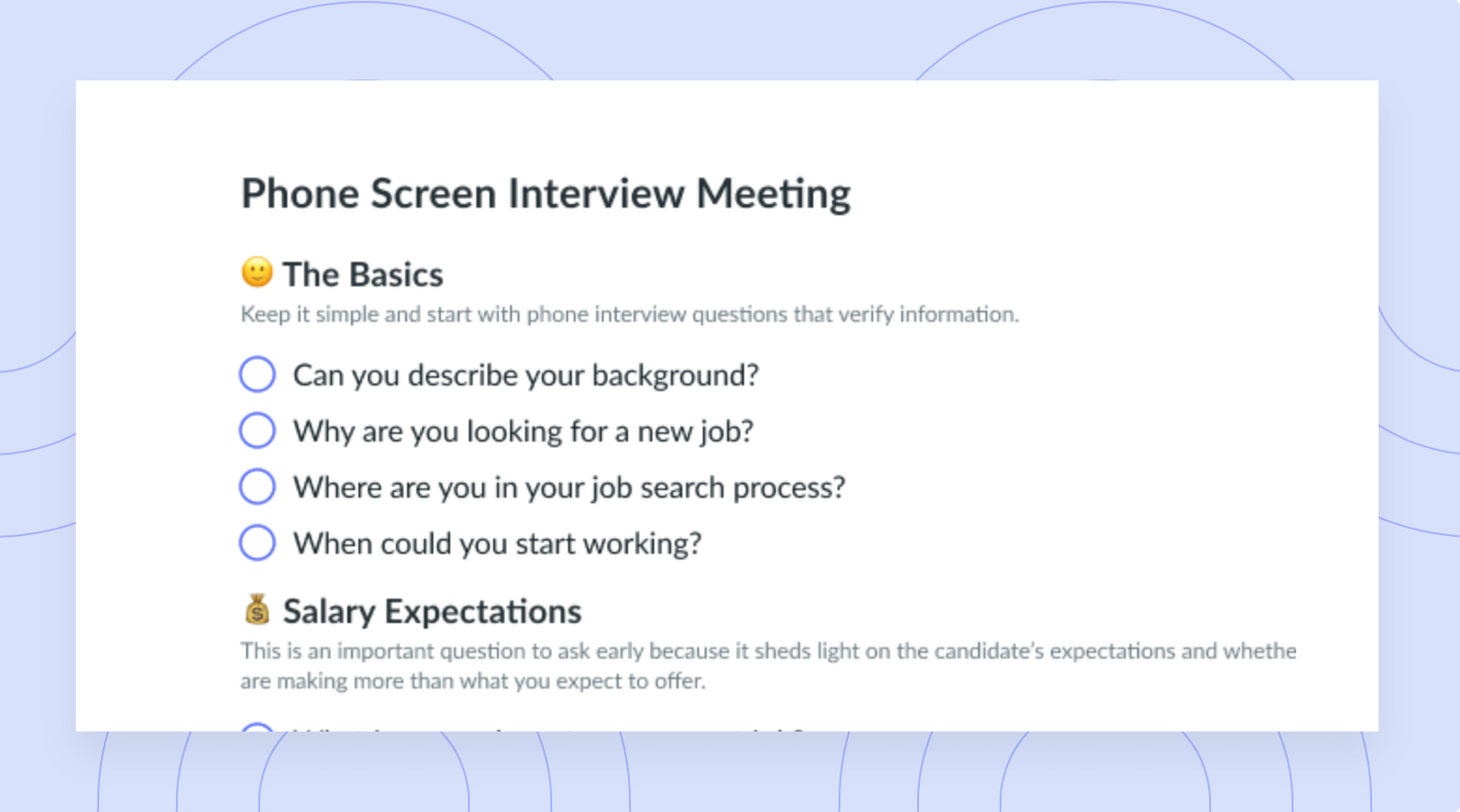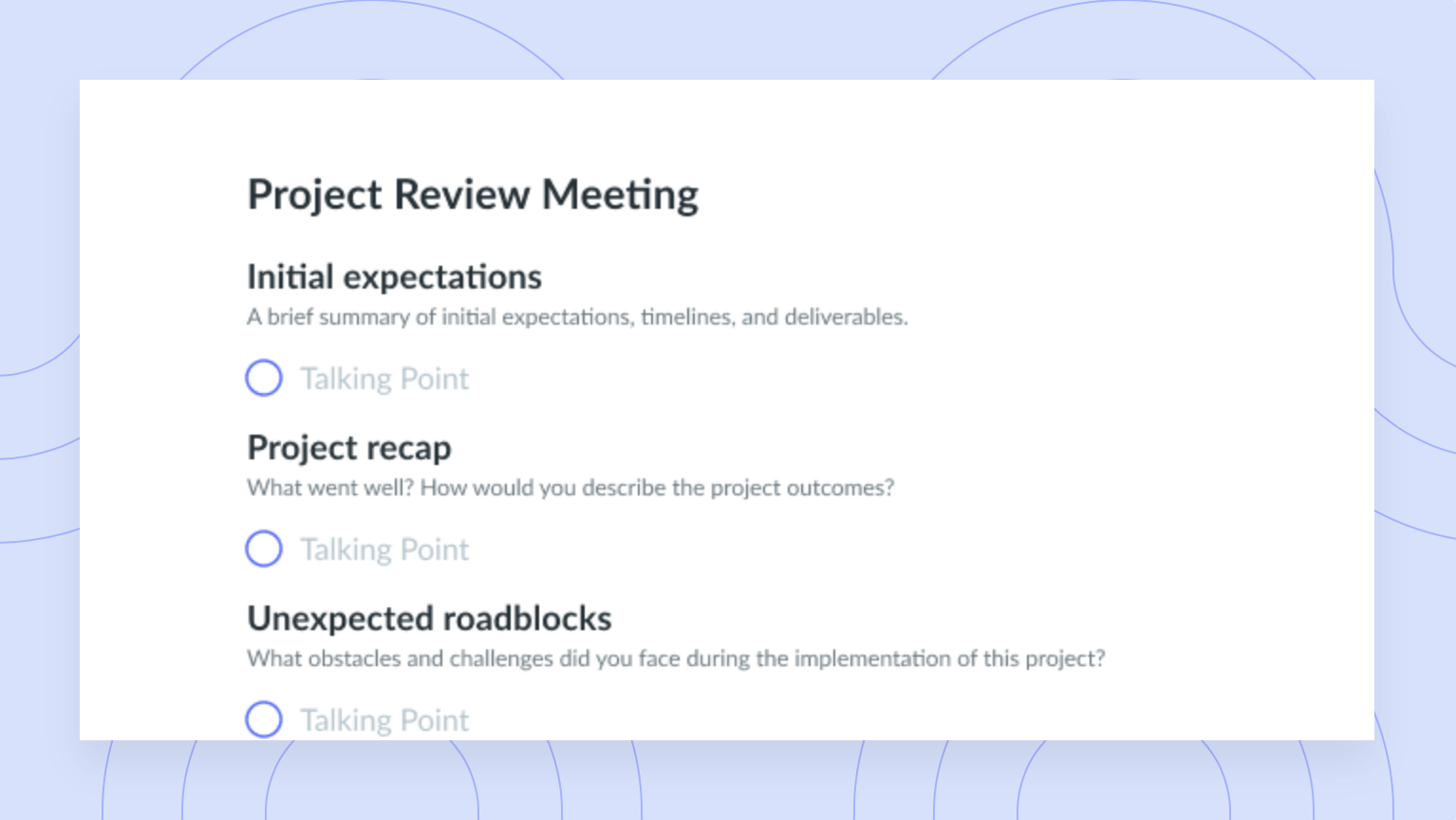How to Create a Meeting Purpose: 8 Tips + Examples
Learn to lead purpose-driven meetings by writing intentional meeting purposes that resonate with your intended audience.
A well-defined meeting purpose helps meeting participants understand the meeting’s significance, sets expectations, and provides a framework for the meeting’s agenda, discussions, and outcomes. When written correctly, the meeting purpose acts as a framework for the entire meeting, ensuring every conversation remains on track, relevant, and productive. Keep reading to learn how to write the perfect meeting purpose that resonates with your intended audience!
- What is a meeting purpose?
- Meeting purpose vs. meeting objective: Three key differences
- Examples of different meeting purposes
- How to write a meeting purpose
- How Fellow supports purpose-driven meetings
What is a meeting purpose?
A meeting purpose, objective, or goal is a clear and concise statement that is meant to communicate the specific reason or intention behind hosting a meeting. To quote Matthias Orgler, Agile Coach, Business Innovator, and Software Engineer, “If done right, meetings perform certain functions better than any other form of communication!”

Run purposeful meetings, come to a decision, and get back to work
Level up your meeting habits to boost engagement and productivity with a collaborative meeting agenda. Try a tool like Fellow!
Meeting purpose vs. meeting objective: Three key differences
A purpose and an objective may sound closely related, but there’s a difference between these terms in the meeting world. While your meeting purpose is the “why” of your meeting, your meeting objectives are what you’ll work toward. While they have different meanings, your meeting purpose and objectives truly go hand in hand. We’ll break down the differences in three main ways:
1General vs. specific
On one hand, a meeting purpose statement encompasses the overall goal of your meeting. Maybe that’s discussing funding options for an annual company gala—sounds fun! A meeting objective, on the other hand, is what your team works to achieve. For this gala example, an objective can be to create a list of potential sponsors and assign each attendee a sponsor or two to contact.
2Cause vs. action
Your meeting purpose brings your team members together under a shared cause. Meeting objectives advance that cause through action items.
Let’s use the gala example again here. Your objectives will acknowledge that you need funding (that’s your purpose) and give your team tasks that fall under that purpose. Outlining a budget, designing the invitation, and finding a venue and caterer are all possible objectives that support the meeting purpose.
3Intangible vs. physical
The purpose of your next meeting might be having a discussion, making a decision, or inspiring and motivating your team. The reasons are endless. They’re also abstract and intangible—you can’t take a specific or measurable action based on a meeting purpose statement alone.
Meeting objectives, however, are items on a checklist that produce tangible results and allow you to track your team’s progress. In the fundraising example above, your team’s discussion (intangible) produces a budget and sheet of paper (physical) detailing prospective gala sponsors.
Examples of different meeting purposes
- Brainstorming meeting
- Decision-making meeting
- Status update
- Project kick-off meeting
- Introductory meeting
1Brainstorming meeting
The purpose of a brainstorming meeting is to generate ideas and problem solve as a collective. Participants in brainstorming meetings often gather to collaborate and encourage innovation by sharing their thoughts, perspectives, and insights without judgment. The goal of these meetings is to create an inclusive environment where ideas flow freely, helping to foster new ideas and solve problems.
2Decision-making meeting
The purpose of a decision-making meeting is to bring together stakeholders together to discuss, evaluate, and make an informed decision. Participants in decision-making meetings aim to make informed decisions by considering all viable options and agreeing on a consensus.
3Status update
The purpose of a status meeting is to provide timely updates that pertain to current projects while fostering alignment, answering questions, and overcoming roadblocks as a team. These meetings serve as a means to ensure all participants are informed about the current status of the work, helping teams stay on track and organized as they work toward shared organizational goals.
4Project kick-off meeting
The purpose of a project kick-off meeting is to kick off a new project, ensuring all attendees are informed and aligned before the project starts. These meetings are often used to review the project’s scope, discuss who is responsible for different components of the project, and answer any questions teammates have before starting the project. These meetings provide an opportunity to foster alignment and kick off the project on a positive note.
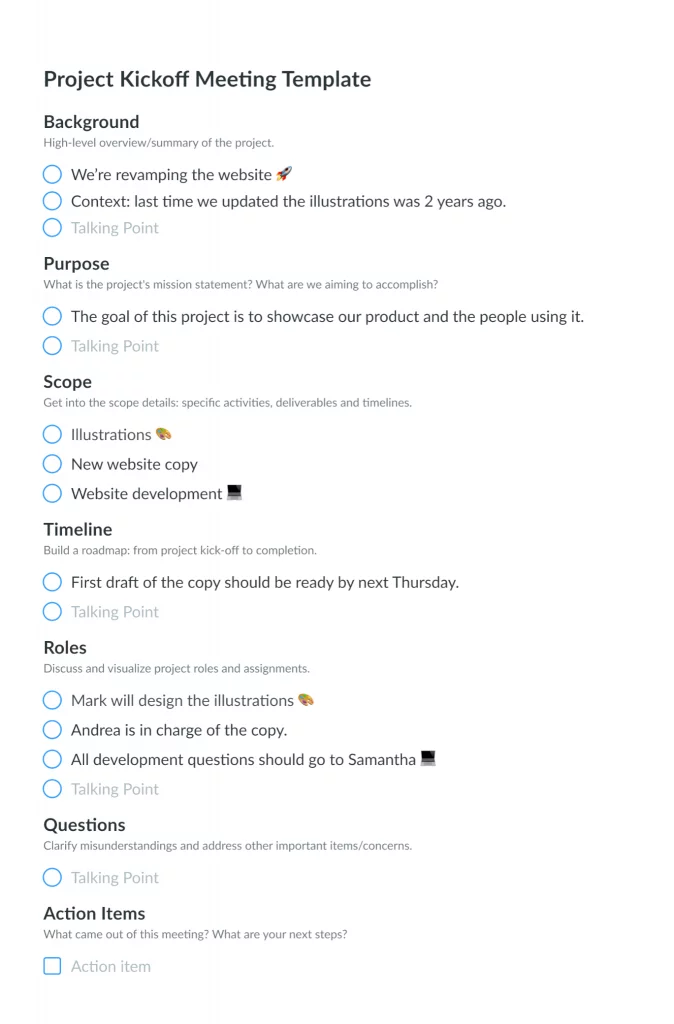
5Introductory meeting
The purpose of an introductory meeting is to introduce a new team member to the rest of the team. These meetings are often used to introduce teammates to one another, share basic information, and set a positive and friendly tone that establishes a foundation for future collaboration.
How to write a meeting purpose
- Determine the type of meeting
- Define the meeting objectives
- Be specific
- Consider the meeting attendees
- Remain consistent
- Set expectations
- Align with company goals
- Share the meeting purpose with all attendees
1Determine the type of meeting
The first step to writing a meeting purpose is determining the type of meeting you’re hosting—you can’t accurately specify your purpose if you haven’t first taken the time to establish the type of meeting you’ll be hosting. For example, if you’re hosting a decision-making meeting, the purpose of your meeting would be to make a decision. If you’re hosting a brainstorming meeting, the purpose of your meeting would be to generate ideas and encourage innovation.
2Define the meeting objectives
A meeting’s purpose and objectives go hand in hand. Meeting objectives define what you intend to achieve during the meeting—such as brainstorming ideas, making a decision, or sharing updates. When you establish your meeting objectives, you gain insights into your desired meeting outcome. This information can then be used to craft an accurate meeting purpose.
With Fellow, you can stay on top of your team’s goals by clearly recording, defining, and tracking the progress of your objectives and key results (OKRs) with its Objectives tool. The best part is that you can quickly review your meeting purpose and objectives during your team meetings, making it easy to review progress, resolve challenges, and keep all OKRs on track.
3Be specific
Being specific when writing a meeting purpose is crucial because specificity ensures clarity, alignment, and focus. There’s nothing worse than gearing up for a meeting only to be confused by the meeting purpose. Writing a clear, concise, and specific meeting purpose will help ensure attendees are on the same page, leaving little to no room for ambiguity or miscommunication. Specificity will also help set expectations and enable participants to prepare for the meeting. To quote Forbes contributor Rodger Dean Duncan, “Being specific about purpose implies what role you expect the participants to play.”
4Consider the meeting attendees
Similar to how determining the type of meeting you’ll be hosting will provide you insights into your meeting purpose, considering meeting attendees will do the same. Understanding the meeting attendees when writing your meeting purpose will ensure your meeting purpose is catered to the needs and expectations of the meeting participants. Considering who will be present during the meeting will help you write a meeting purpose that addresses the audience’s unique concerns, interests, and roles, ensuring the meeting purpose resonates with the intended audience.
5Remain consistent
Consistency is key, especially when writing meeting purposes. It’s important to remain consistent and write clear, concise meeting purposes for all meetings, not just certain ones. With its Meeting Guidelines feature set, Fellow helps ensure every meeting has a clear purpose. When you create a meeting using Fellow, you’ll be prompted to add a meeting purpose to the description of the meeting, ensuring every meeting is defined and organized from the start.
6Set expectations
Setting expectations when writing your meeting purpose helps meeting participants understand the meeting purpose and what they can expect, helping to reduce confusion and anxiety. Additionally, when participants know what to expect after reading the meeting purpose, they are more likely to show up to the meeting prepared and engage in the conversation, contributing to a more effective and successful meeting.
7Align with company goals
When writing the meeting purpose for any meeting—whether it’s for a skip-level meeting, a brainstorming meeting, or an asynchronous meeting—it’s important to make sure it’s aligned with company goals. Verifying that your meeting purpose and objectives are aligned with company goals will help ensure your meeting is strategically driven and directly contributing to the organization’s overarching objectives. This level of alignment will ensure your team is contributing effectively to achieving shared organizational goals.
8Share the meeting purpose with all attendees
Whether you’re writing a skip-level meeting purpose, a decision-making meeting purpose, a skip meeting purpose, or a brainstorming meeting purpose, it’s important to share the meeting purpose with attendees before the meeting starts. Fellow’s Meeting Guidelines feature set will provide you with all the help you need so every meeting has a meeting purpose that is visible to all meeting attendees with Google Meet invitations.
How Fellow supports purpose-driven meetings
To quote this case study involving Fellow:
“The difficulty surrounding meetings usually stems from teams and organizations being uneducated about running productive meetings and the benefits effective meetings have on the business. This is where Nicola stepped in and told the executive team at Jimdo about Fellow – the meeting management tool that helped his team be more productive at his previous company.”
Fellow’s Meeting Guidelines are curated methodically to help ensure every meeting is purpose driven. As a people leader or manager, you can leverage Fellow’s Meeting Guidelines feature set to ensure meetings are purpose driven by building no-meeting days and breaks between meetings directly into your calendar capabilities, ensuring meeting attendees are showing up to every meeting energized and ready to contribute. You can even use this feature set to determine a maximum number of meeting hours per week, creating more time for focus and execution and ensuring your team isn’t overdoing it with meetings.
Additionally, Fellow’s AI features can help facilitate purpose-driven meetings by acting as a meeting assistant, making it easier than ever to plan, attend, and capture great meetings! Fellow’s AI-generated meeting agendas help you build thoughtful meeting agendas, and our AI meeting transcriptions elevate your meetings and help everyone stay present and engaged.
Lead purpose-driven meetings by writing intentional meeting purposes
Regardless of whether you’re writing a skip-level meeting purpose, a brainstorming meeting purpose, or a skip meeting purpose, it’s important to be clear, concise, and specific. Implementing the best practices listed above when writing your next meeting purpose will ensure you have everything you need to write a meeting purpose that resonates with your intended audience.

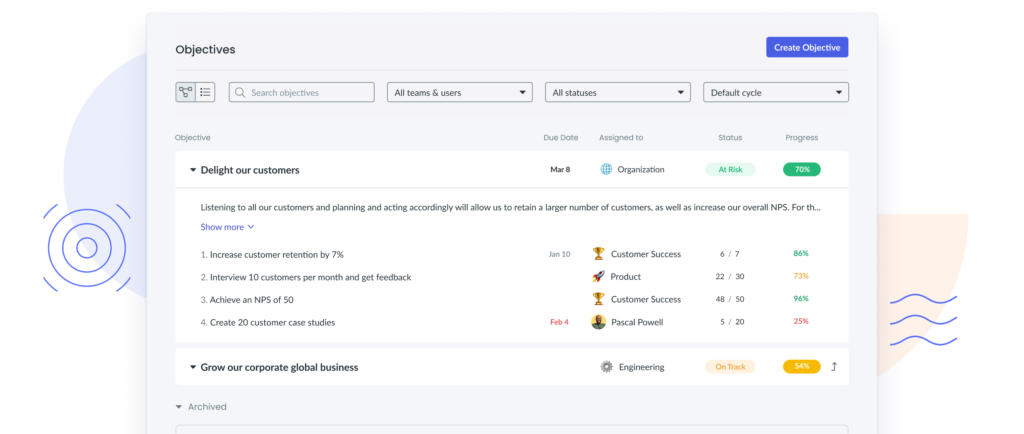
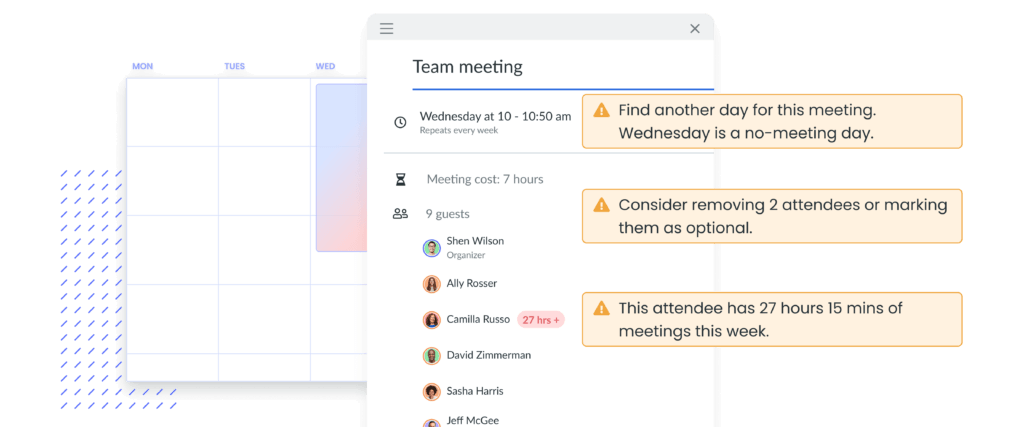

![On-Call Engineering Best Practices [+ Pros & Cons]](https://fellow.app/wp-content/uploads/2022/09/On-Call-Engineering-Best-Practice.jpg)






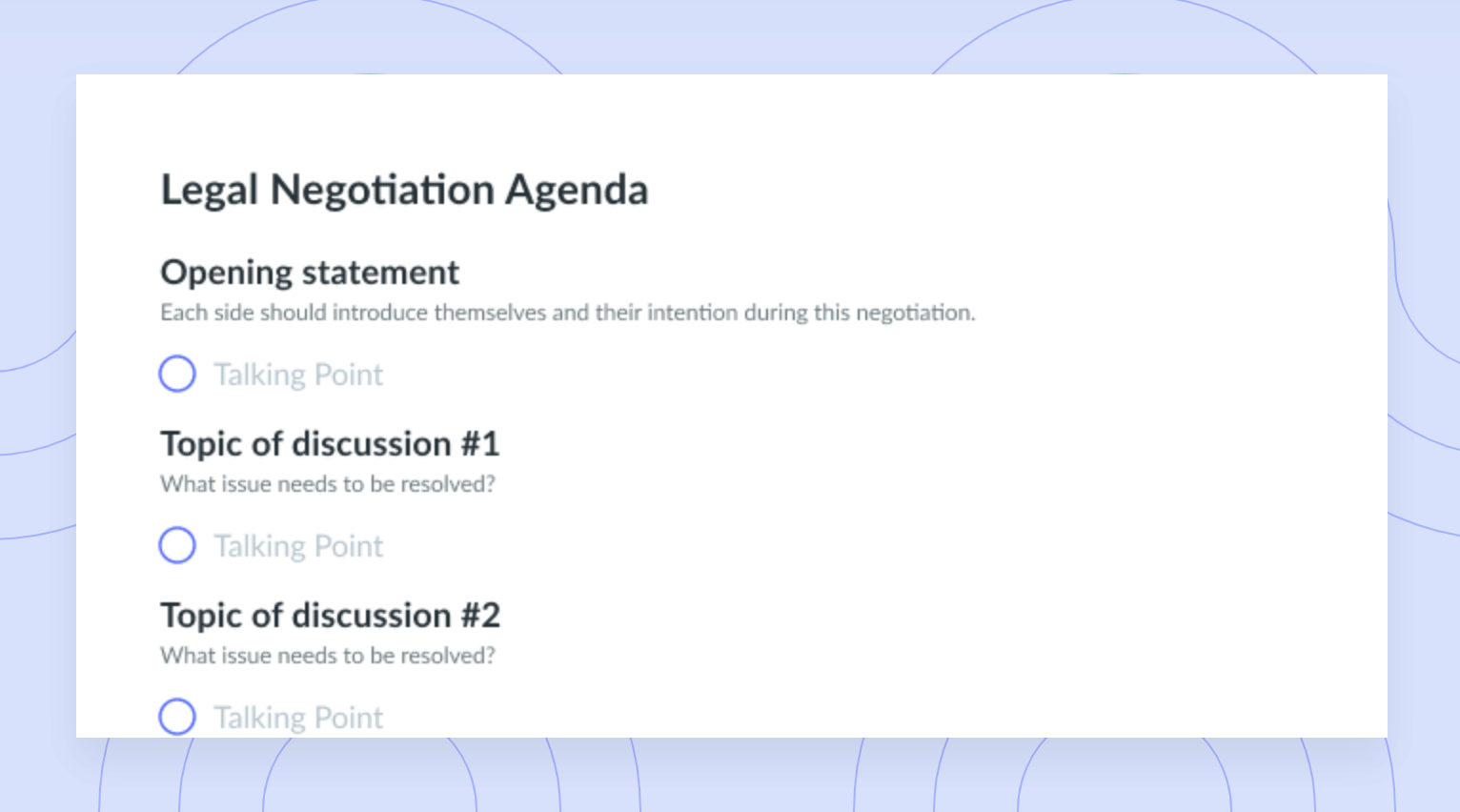
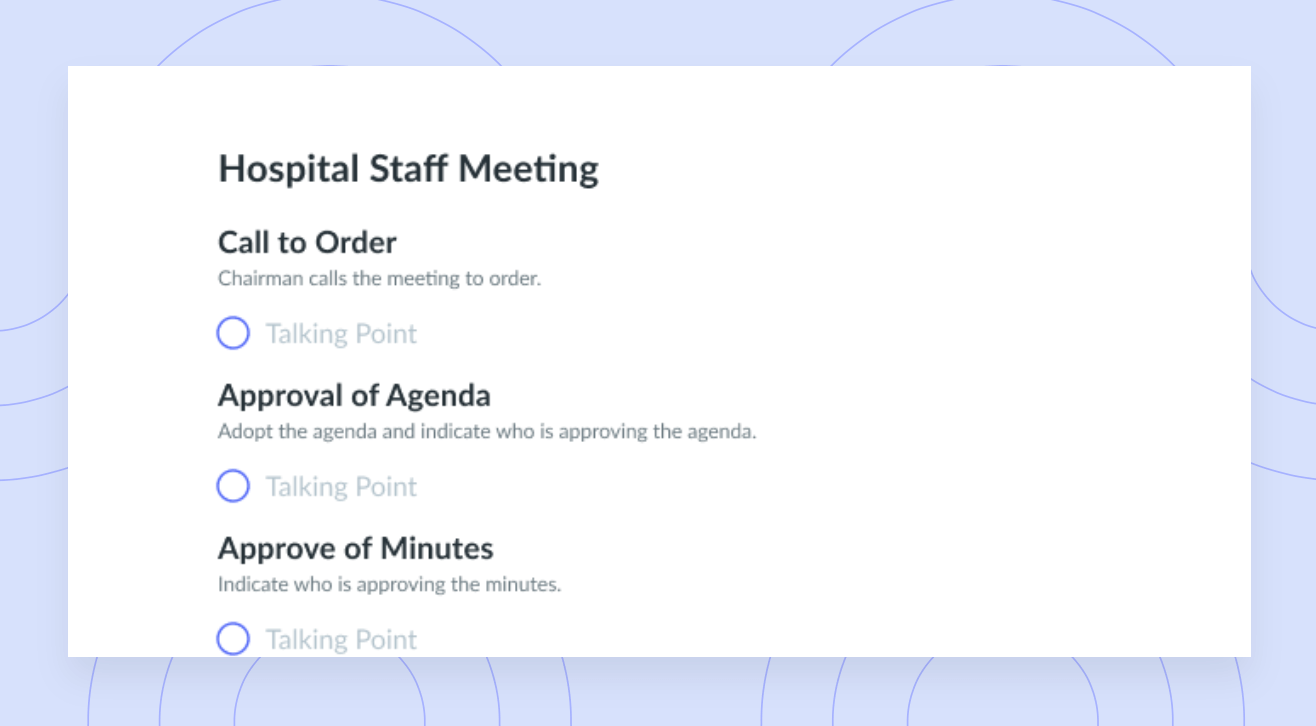



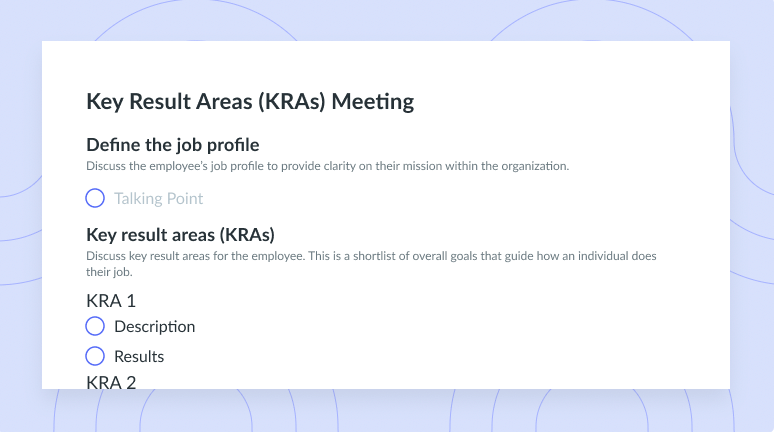
![Incoming Client Interview [Legal Clinic] Template](https://fellow.app/wp-content/uploads/2021/09/Incoming-Client-Interview-Legal-Clinic-preview.png)
